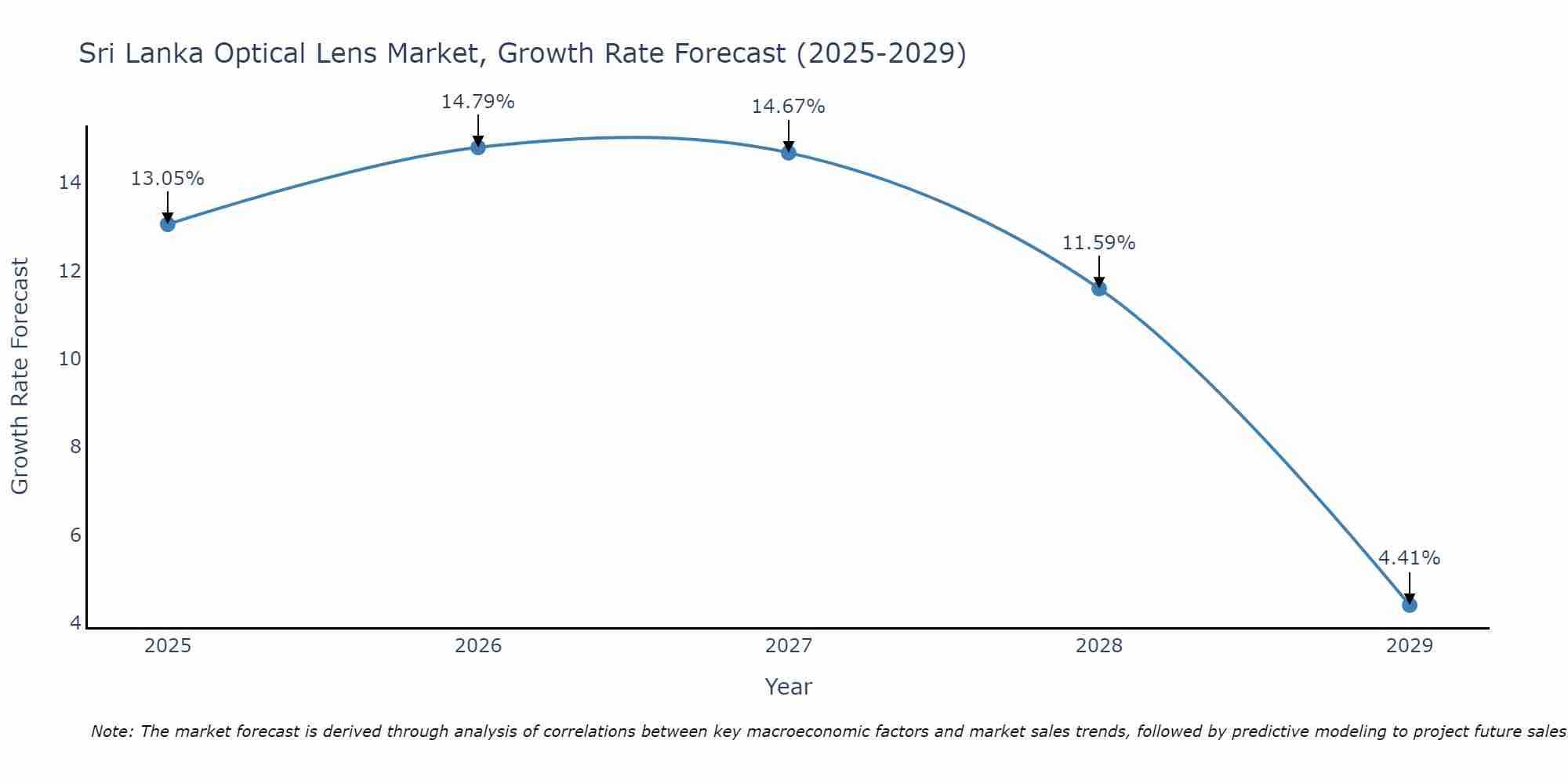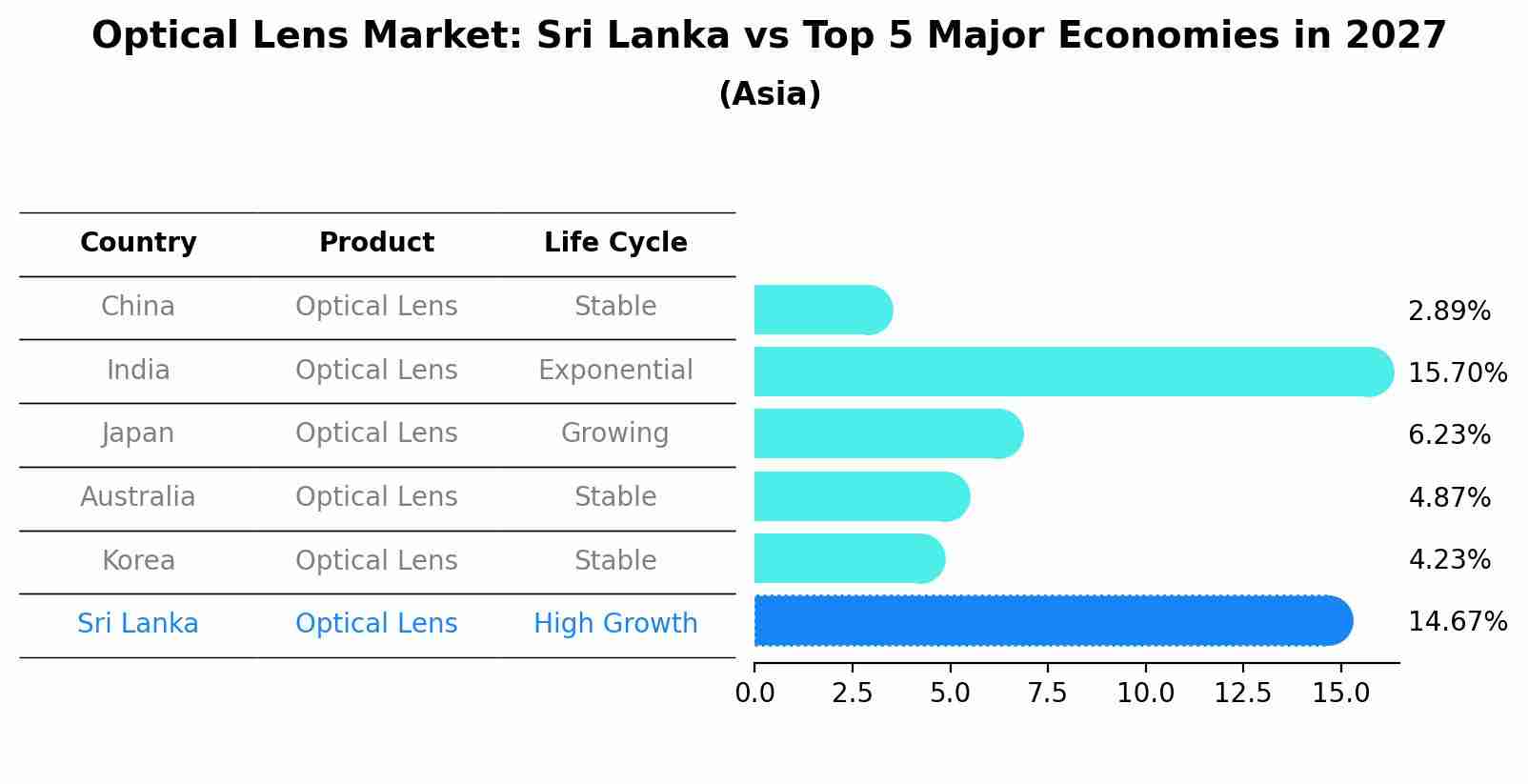Sri Lanka Optical Lens Market Outlook | Trends, Growth, Companies, Revenue, Industry, Analysis, Size, Forecast, Value, Share & COVID-19 IMPACT
| Product Code: ETC367951 | Publication Date: Aug 2022 | Updated Date: Jul 2025 | Product Type: Market Research Report | |
| Publisher: 6Wresearch | Author: Dhaval Chaurasia | No. of Pages: 75 | No. of Figures: 35 | No. of Tables: 20 |
Sri Lanka Optical Lens Market Size Growth Rate
The Sri Lanka Optical Lens Market is projected to witness mixed growth rate patterns during 2025 to 2029. Starting at 13.05% in 2025, the market peaks at 14.79% in 2026, and settles at 4.41% by 2029.

Optical Lens Market: Sri Lanka vs Top 5 Major Economies in 2027 (Asia)
The Optical Lens market in Sri Lanka is projected to grow at a high growth rate of 14.67% by 2027, within the Asia region led by China, along with other countries like India, Japan, Australia and South Korea, collectively shaping a dynamic and evolving market environment driven by innovation and increasing adoption of emerging technologies.

Sri Lanka Optical Lens Market Synopsis
The Sri Lanka Optical Lens Market is experiencing steady growth due to factors such as increasing awareness about eye health, rising prevalence of vision-related disorders, and improving healthcare infrastructure in the country. The market is primarily driven by the demand for corrective lenses, including eyeglasses and contact lenses, as well as a growing preference for specialty lenses such as blue light blocking and photochromic lenses. Key players in the market are focusing on product innovation, technological advancements, and strategic partnerships to gain a competitive edge. Additionally, the increasing adoption of online retail channels for purchasing optical lenses is further propelling market growth. Overall, the Sri Lanka Optical Lens Market is poised for continued expansion in the coming years as consumer demand for vision correction solutions continues to rise.
Sri Lanka Optical Lens Market Trends
The Sri Lanka Optical Lens Market is experiencing several key trends. One significant trend is the growing demand for specialty lenses, such as blue light blocking lenses, progressive lenses, and photochromic lenses, driven by increasing awareness of eye health and the benefits of these advanced lens technologies. Additionally, there is a shift towards lightweight and more durable lens materials like polycarbonate and high-index plastics, as consumers seek greater comfort and convenience in their eyewear. Another emerging trend is the rise of online optical retailers offering a wider selection of lenses and frames, presenting a convenient alternative to traditional brick-and-mortar stores. As the market continues to evolve, customization and personalization of lenses to cater to individual preferences and needs are also gaining traction among consumers in Sri Lanka.
Sri Lanka Optical Lens Market Challenges
In the Sri Lanka optical lens market, challenges include increasing competition from international players, fluctuating raw material costs, and limited awareness about the importance of regular eye check-ups among the population. The market is also hindered by the presence of counterfeit products, which affects the credibility of genuine optical lens brands. Additionally, the lack of skilled professionals in the optical industry poses a challenge in providing quality services and products to consumers. Furthermore, the economic instability in the country can impact consumer spending on non-essential items like eyewear, leading to fluctuations in demand. Overall, navigating these challenges requires strategic marketing efforts, quality assurance measures, and investments in education and training to ensure sustainable growth in the Sri Lanka optical lens market.
Sri Lanka Optical Lens Market Investment Opportunities
The Sri Lanka Optical Lens Market presents promising investment opportunities due to the increasing demand for eyewear products driven by factors such as a growing awareness of vision health, rising disposable incomes, and a changing lifestyle. With a significant portion of the population requiring vision correction, there is a steady demand for optical lenses, both prescription and non-prescription. Investing in this market could be lucrative, especially in areas such as high-quality lenses, innovative lens technologies, and fashionable eyewear designs. Additionally, the market is witnessing a shift towards online retail channels, offering opportunities for e-commerce platforms and digital marketing strategies. Overall, investing in the Sri Lanka Optical Lens Market presents a favorable outlook for investors looking to capitalize on the growing demand for eyewear products in the country.
Jordan Agar Market Government Policies
The Sri Lankan government has implemented several policies to regulate the optical lens market. One key policy is the imposition of import tariffs on optical lenses to protect local manufacturers and promote domestic production. Additionally, the government has introduced quality standards and regulations to ensure the safety and effectiveness of optical lenses sold in the market. Furthermore, there are initiatives in place to promote research and development in the optical industry to enhance innovation and competitiveness. The government also encourages investment in the sector through incentives and support programs to foster growth and expansion. Overall, these policies aim to create a conducive environment for the development of the optical lens market in Sri Lanka while safeguarding consumer interests and promoting local industry.
Sri Lanka Optical Lens Market Future Outlook
The future outlook for the Sri Lanka Optical Lens Market appears promising, driven by factors such as increasing awareness about eye health, rising prevalence of vision-related disorders, and growing adoption of eyewear for both corrective and fashion purposes. With a growing middle-class population and increasing disposable income levels, there is a rising demand for high-quality optical lenses in the country. Additionally, technological advancements in lens manufacturing and design are expected to further boost market growth. However, the market may face challenges such as intense competition from global players and the availability of counterfeit products. Overall, the Sri Lanka Optical Lens Market is projected to witness steady growth in the coming years, presenting opportunities for both domestic and international manufacturers to expand their presence in the region.
Key Highlights of the Report:
- Sri Lanka Optical Lens Market Outlook
- Market Size of Sri Lanka Optical Lens Market, 2021
- Forecast of Sri Lanka Optical Lens Market, 2031
- Historical Data and Forecast of Sri Lanka Optical Lens Revenues & Volume for the Period 2018 - 2031
- Sri Lanka Optical Lens Market Trend Evolution
- Sri Lanka Optical Lens Market Drivers and Challenges
- Sri Lanka Optical Lens Price Trends
- Sri Lanka Optical Lens Porter's Five Forces
- Sri Lanka Optical Lens Industry Life Cycle
- Historical Data and Forecast of Sri Lanka Optical Lens Market Revenues & Volume By Type for the Period 2018 - 2031
- Historical Data and Forecast of Sri Lanka Optical Lens Market Revenues & Volume By Converging Lenses for the Period 2018 - 2031
- Historical Data and Forecast of Sri Lanka Optical Lens Market Revenues & Volume By Diverging Lenses for the Period 2018 - 2031
- Historical Data and Forecast of Sri Lanka Optical Lens Market Revenues & Volume By Application for the Period 2018 - 2031
- Historical Data and Forecast of Sri Lanka Optical Lens Market Revenues & Volume By Ophthalmic for the Period 2018 - 2031
- Historical Data and Forecast of Sri Lanka Optical Lens Market Revenues & Volume By Microscopy for the Period 2018 - 2031
- Historical Data and Forecast of Sri Lanka Optical Lens Market Revenues & Volume By Laser Processing for the Period 2018 - 2031
- Historical Data and Forecast of Sri Lanka Optical Lens Market Revenues & Volume By Imaging for the Period 2018 - 2031
- Historical Data and Forecast of Sri Lanka Optical Lens Market Revenues & Volume By End-User for the Period 2018 - 2031
- Historical Data and Forecast of Sri Lanka Optical Lens Market Revenues & Volume By Consumer Electronics for the Period 2018 - 2031
- Historical Data and Forecast of Sri Lanka Optical Lens Market Revenues & Volume By Defense for the Period 2018 - 2031
- Historical Data and Forecast of Sri Lanka Optical Lens Market Revenues & Volume By Healthcare for the Period 2018 - 2031
- Historical Data and Forecast of Sri Lanka Optical Lens Market Revenues & Volume By Life Sciences for the Period 2018 - 2031
- Historical Data and Forecast of Sri Lanka Optical Lens Market Revenues & Volume By Others for the Period 2018 - 2031
- Sri Lanka Optical Lens Import Export Trade Statistics
- Market Opportunity Assessment By Type
- Market Opportunity Assessment By Application
- Market Opportunity Assessment By End-User
- Sri Lanka Optical Lens Top Companies Market Share
- Sri Lanka Optical Lens Competitive Benchmarking By Technical and Operational Parameters
- Sri Lanka Optical Lens Company Profiles
- Sri Lanka Optical Lens Key Strategic Recommendations
Frequently Asked Questions About the Market Study (FAQs):
- Single User License$ 1,995
- Department License$ 2,400
- Site License$ 3,120
- Global License$ 3,795
Search
Thought Leadership and Analyst Meet
Our Clients
Related Reports
- Afghanistan Apparel Market (2026-2032) | Growth, Outlook, Industry, Segmentation, Forecast, Size, Companies, Trends, Value, Share, Analysis & Revenue
- Canada Oil and Gas Market (2026-2032) | Share, Segmentation, Value, Industry, Trends, Forecast, Analysis, Size & Revenue, Growth, Competitive Landscape, Outlook, Companies
- Germany Breakfast Food Market (2026-2032) | Industry, Share, Growth, Size, Companies, Value, Analysis, Revenue, Trends, Forecast & Outlook
- Australia Briquette Market (2025-2031) | Growth, Size, Revenue, Forecast, Analysis, Trends, Value, Share, Industry & Companies
- Vietnam System Integrator Market (2025-2031) | Size, Companies, Analysis, Industry, Value, Forecast, Growth, Trends, Revenue & Share
- ASEAN and Thailand Brain Health Supplements Market (2025-2031) | Strategy, Consumer Insights, Analysis, Investment Trends, Opportunities, Growth, Size, Share, Industry, Revenue, Segments, Value, Segmentation, Supply, Forecast, Restraints, Outlook, Competition, Drivers, Trends, Demand, Pricing Analysis, Competitive, Strategic Insights, Companies, Challenges
- ASEAN Bearings Market (2025-2031) | Strategy, Consumer Insights, Analysis, Investment Trends, Opportunities, Growth, Size, Share, Industry, Revenue, Segments, Value, Segmentation, Supply, Forecast, Restraints, Outlook, Competition, Drivers, Trends, Demand, Pricing Analysis, Competitive, Strategic Insights, Companies, Challenges
- Europe Flooring Market (2025-2031) | Outlook, Share, Industry, Trends, Forecast, Companies, Revenue, Size, Analysis, Growth & Value
- Saudi Arabia Manlift Market (2025-2031) | Outlook, Size, Growth, Trends, Companies, Industry, Revenue, Value, Share, Forecast & Analysis
- Uganda Excavator, Crane, and Wheel Loaders Market (2025-2031) | Strategy, Consumer Insights, Analysis, Investment Trends, Opportunities, Growth, Size, Share, Industry, Revenue, Segments, Value, Segmentation, Supply, Forecast, Restraints, Outlook, Competition, Drivers, Trends, Demand, Pricing Analysis, Competitive, Strategic Insights, Companies, Challenges
Industry Events and Analyst Meet
Whitepaper
- Middle East & Africa Commercial Security Market Click here to view more.
- Middle East & Africa Fire Safety Systems & Equipment Market Click here to view more.
- GCC Drone Market Click here to view more.
- Middle East Lighting Fixture Market Click here to view more.
- GCC Physical & Perimeter Security Market Click here to view more.
6WResearch In News
- Doha a strategic location for EV manufacturing hub: IPA Qatar
- Demand for luxury TVs surging in the GCC, says Samsung
- Empowering Growth: The Thriving Journey of Bangladesh’s Cable Industry
- Demand for luxury TVs surging in the GCC, says Samsung
- Video call with a traditional healer? Once unthinkable, it’s now common in South Africa
- Intelligent Buildings To Smooth GCC’s Path To Net Zero


















